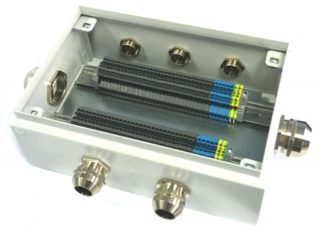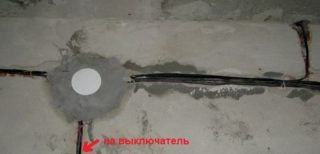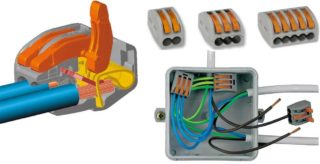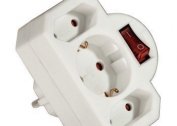Junction box - type of mounting device. There are a number of alternative product names: branching, connecting, wiring or junction box with terminal blocks, distribution box. This is the basic tool for organizing the power grid in industrial and domestic conditions. The housing accommodates a circuit of a limited section of the circuit, protects the branching branch of the wiring, simplifies access to it for repair, modernization, and prevents a person from contacting bare veins. Easy connection and secure connections are provided by integrated terminals for junction boxes.
Distribution Box Selection Algorithm
The location of the device is the first criterion for its selection. Markings will indicate suitable operating conditions. The types of climatic modification are widespread: U1, U2, U3, where U is use in a temperate climate, 1 is an outdoor variant, 2 is located under a canopy, 3 is indoors.
IP protection level **. In dry rooms, IP20 is sufficient, conditions of high humidity and open spaces will require IP44, IP55, IP65.
Case material: aluminum, steel or refractory plastic. Thick-walled steel boxes are placed at production facilities in places with an increased risk of fires. In residential and administrative buildings, polymer models are more common. The exception is wooden houses, in which metal boxes are mandatory for installation.
Terminal boxes with terminal blocks differ in the nature of the wall on which they will be fixed. The manufacturer indicates the relevant information in the product description: drywall, brick, hollow, concrete, wooden walls and their thickness.
The type and distribution scheme of the power grid determines the size of the product, the number of holes in it. External wiring involves overhead (external) devices, hidden - internal (secret). The number of placed cable contacts affects the dimensions of the electrical box and directly the terminal block in it, the number of holes. In this case, the margin for possible additions to the network also needs to be taken into account. The terminal blocks have 2–5 poles, which makes it possible to use them in single-phase, three-phase networks of types TN-C, TN-S, TN-C-S.
Personal preferences are another condition for choosing the right model among the diversity on the market. Manufacturers produce round and rectangular (square) products, use different colors. Boxing covers open, move back, are removed completely, some are sealed.
Installation and replacement of the soldering box
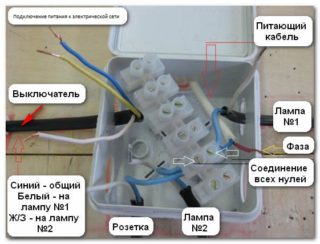 Exclusion combines the concepts of connection and distribution. At the initial stage, it is necessary to consider the location of the branches. A large number of electrical consumers involves the use of a number of boxes: input, walk-through. More than 8 connections should not converge in one node.
Exclusion combines the concepts of connection and distribution. At the initial stage, it is necessary to consider the location of the branches. A large number of electrical consumers involves the use of a number of boxes: input, walk-through. More than 8 connections should not converge in one node.
- Overhead models do not require a specially equipped socket, unlike secret ones. If the base is solid (concrete, brick), a recess is drilled in the wall with a special crown, the soldering box in it is fixed with a mortar and self-tapping screws. Hollow and drywall partitions allow the device to be fixed with fixing clamps.
- After securing the case, the cable is inserted into the distribution box. They enter through special openings sealed with membranes or gaskets.
- The next stage is the stripping of cores from general and individual isolation.In the arsenal of electricians there is a tool adapted for this work, but you can get by with a simple knife. The minimum length of the “bare” edge should be 4–5 cm, be designed for reconnection without excessive tension.
- When working with multi-wire conductors, lugs are used that facilitate the fastening of the wire and eliminate the possibility of damage to thin wires of the conductor.
- Resumption of power is carried out after checking the correct assembly.
The location of the power supply nodes is subject to the PUE. This should be considered when planning a new wiring or when upgrading an existing one. The main thing is accessibility, the lid should not be hidden deeper than a sheet of wallpaper or a thin layer of putty. The distribution is placed on the same line as sockets or switches 20-30 cm below the ceiling.
In old houses, the feature of the location of the mounting boxes is determined by the type of development:
- "Stalin" - the boxes are located in the cavities, so the walls are tapped;
- "Khrushchev" - the iron caps protrude by 20 mm;
- “Brezhnevka” - the places between the wall and the ceiling pass through a metal detector in order to calculate galvanization;
- panel high-rise building - the lines from outlets are examined with a screwdriver indicator, in the right place the brightness of the bulb will increase;
- in the case of drywall, you need a hidden wiring detector.
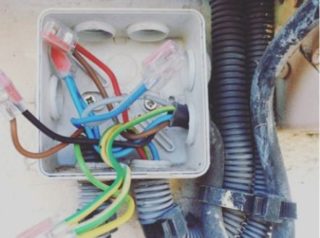
Even a high-quality and expensive device does not insure against errors during the installation process. Among the most common are:
- ill-conceived branching, wiring diagrams;
- the choice of contact devices does not match the cable cross-section, the network voltage;
- the box is selected without a supply of space, which is inconvenient and unsafe;
- oxide films are not removed from the surface of the conductors;
- the selected sleeves do not correspond to multi-wire cores;
- the wire end is not deep enough into the cavity of the terminal block;
- tension creates a mechanical breaking load on the joints.
High-quality implementation of all stages of the exclusion will ensure the full functioning of the network.
Types and advantages of connection terminals
Among the traditional methods of switching wires, the terminals are easy to install and can be easily disassembled, but with a lower safe load. By the type of connection there are:
- screw;
- spring;
- knife
The wires that are fixed with screws cannot be of different metals. For stranded wires, brass lugs must be used. The diameter of the clamping screws depends on the cross section and the number of cores that close. Check and tighten the connections annually.
Self-locking terminals are used both for one-piece connections, and for reusable. The difference lies in the stiffness of the spring.
The advantages of contacts in such pads are the ability to combine wires of different sections, compensation of conductor deformation by spring pressure, vibration resistance, core integrity with multiple connections, ease of installation and speed.
Knife-like contacts are needed where a continuous core (neutral) is required. Such devices save time on stripping insulation, as they cut it on their own.
If it was not possible to select the necessary terminal electrical box, you can select the pads and place in a universal hollow product.
